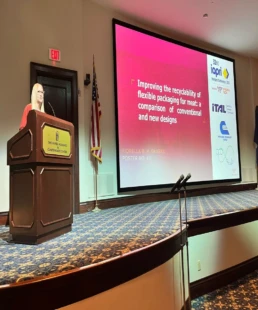
Fiorella Dantas, pesquisadora da Plataforma 3 do CCD Circula (Design, materiais e tecnologias inovadoras), apresentou os primeiros resultados da pesquisa intitulada ‘Improving the recyclability of flexible packaging for meat: a comparison of conventional and new designs’ na 32nd IAPRI Member’s Conference 2025 em Roanoke, Estados Unidos. A pesquisa investigou como melhorar a reciclabilidade de embalagens flexíveis para produtos cárneos, um dos maiores desafios da indústria alimentícia atual.
O estudo comparou dois tipos de embalagem multicamada para carne: as tradicionais, que usam um material chamado PVDC e não são passíveis de reciclagem, com uma nova versão já disponível no mercado para utilização com outras categorias de produto. Nesta nova embalagem, o PVDC foi substituído por outros materiais que permitem a reciclagem. Os resultados se mostraram promissores principalmente em relação ao shelf life do produto.
Os resultados demonstraram que o novo design mantém as propriedades essenciais de barreira contra oxigênio e umidade, fundamentais para preservar a qualidade dos produtos cárneos, enquanto oferece uma solução mais sustentável.
Outros autores da pesquisa são os pesquisadores Nanci Castanha, Gustavo H. Moraes e Luís M. Júnior.
Confira o abstract do trabalho (em inglês)
Flexible plastic packaging for fresh meat products plays a critical role in preserving product quality through its moisture and oxygen barrier properties. However, the complex multilayer structure of these packages, often incorporating materials like PVDC, significantly complicates recycling. This study investigates a new design for multilayer flexible packaging aimed at improving recyclability while maintaining essential functional properties. Five commercial vacuum-packed meat samples were characterized using FT-IR, DSC, and microscopy to determine their material composition. The packaging structures were found to consist of PE, EVA, and PVDC. Using the RecyClass tool, these packages were classified as "Not Recyclabe", indicating that they are not recyclable due to fundamental design issues, primarily the inclusion of PVDC. In response, we propose a redesign of the packaging structure, replacing PVDC with EVOH (≤ 5%) and PA layers, resulting in a new multilayer configuration. According to RecyClass, this new design would be classified as "CLASS C", indicating that it is recyclable, but with some recyclability issues, with potential improvements in recycling processes and the possibility of closed-loop schemes. While recyclability improves with the new design, both the PVDC-based and the EVOH+PA-based packaging were analysed for their barrier properties and mechanical performance to ensure that product shelf life is not compromised. The PVDC-based packaging showed superior mechanical performance, but the redesigned sample (EVOH+PA) performed better in terms of barrier properties, especially against oxygen. These results suggest that the redesigned packaging has strong potential
to replace the conventional packaging used in commercial samples, providing a better balance between recyclability and product performance. Achieving this balance is critical to ensuring environmental benefits without contributing to food waste. This work offers a promising approach to redesigning flexible meat packaging, combining sustainability advantages with technological feasibility for the meat packaging industry.
